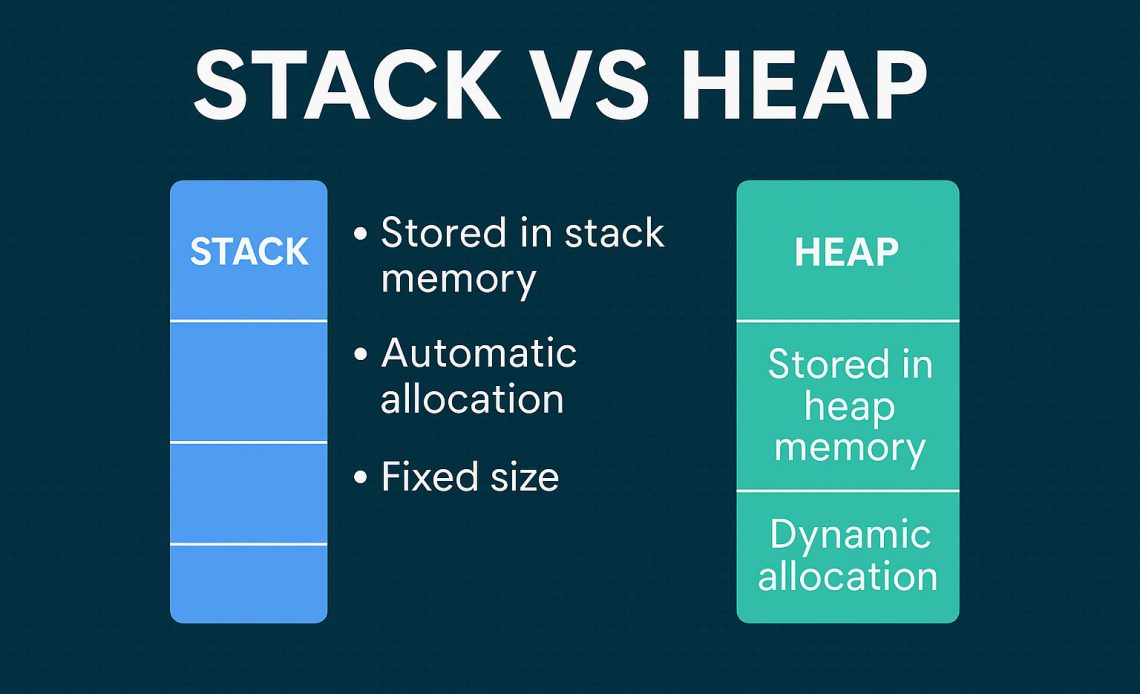
Introduction
When a program runs, it needs memory to store:
- Instructions
- Variables
- Function calls
- Dynamic data
This memory is primarily allocated in two major regions:
- Stack
- Heap
Understanding how and when memory is allocated in the stack or heap is essential for writing efficient, safe, and bug-free code.
1. What Is the Stack?
The stack is a region of memory used for:
- Function calls
- Local variables
- Control flow (return addresses)
It follows a Last In, First Out (LIFO) structure: the most recent function call is the first to be removed.
Key Features:
- Memory is automatically managed
- Fast allocation and deallocation
- Grows downwards in memory
Example (C):
void foo() {
int x = 5; // allocated on the stack
}2. What Is the Heap?
The heap is a region of memory used for:
- Dynamically allocated objects
- Data that must outlive function scopes
- Large and flexible memory use
Memory on the heap must be manually allocated and deallocated (or managed by a garbage collector).
Key Features:
- Memory is manually or semi-automatically managed
- Slower allocation
- Grows upwards in memory
Example (C):
int* p = malloc(sizeof(int)); // allocated on the heap
*p = 10;
free(p);3. Stack vs Heap: A Feature Comparison
| Feature | Stack | Heap |
|---|---|---|
| Memory Lifetime | Temporary (per function call) | Flexible (controlled by programmer) |
| Allocation | Automatic | Manual (malloc, new) or GC |
| Deallocation | Automatic | Manual (free, delete) or GC |
| Access Speed | Very fast (contiguous memory) | Slower (fragmented memory) |
| Size Limit | Usually small (e.g., 1–8 MB) | Much larger (limited by system) |
| Usage | Local variables, function frames | Objects, dynamic data structures |
| Thread Safety | Thread-safe (each thread has its own stack) | Must be synchronized manually |
| Memory Fragmentation | No | Yes (external fragmentation) |
| Error Risk | Stack overflow | Memory leaks, dangling pointers |
4. Visualization of Stack vs Heap
|----------------------------| ← High Memory
| Stack (grows down) |
|----------------------------|
| Free space |
|----------------------------|
| Heap (grows up) |
|----------------------------| ← Low MemoryThe stack and heap grow toward each other. If they collide, it causes a stack or heap overflow.
5. Stack Allocation in Practice
Example (C):
int add(int a, int b) {
int sum = a + b; // sum is stored on the stack
return sum;
}- All parameters (
a,b) and local variables (sum) are stored on the stack frame for this function call. - Once the function returns, memory is automatically reclaimed.
6. Heap Allocation in Practice
Example (C++):
int* arr = new int[100]; // allocated on the heap
arr[0] = 42;
delete[] arr; // must manually deallocate- Useful when the size is not known at compile time
- Required when object lifespan is longer than the calling function
7. Common Errors
Stack Overflow:
Occurs when:
- Too many nested function calls
- Excessive stack-allocated variables (e.g., huge arrays)
void recurse() {
int a[10000];
recurse();
}Memory Leak (Heap):
Occurs when:
- Heap memory is allocated but never freed
- System loses reference to that memory
int* p = malloc(100);
// forgot to free(p);8. Stack and Heap in Different Languages
| Language | Stack Usage | Heap Usage |
|---|---|---|
| C/C++ | Manual (local vars) | Manual with malloc/new |
| Java | Stack for primitive local vars | Heap for all objects (GC-managed) |
| Python | Stack frames for function calls | Everything is heap-allocated |
| Go | Escape analysis decides | Automatic GC |
| Rust | Stack by default, Box for heap | Memory safety enforced at compile time |
Most modern languages rely heavily on heap + garbage collection, but stack usage is still critical for performance.
9. Performance Considerations
| Factor | Stack | Heap |
|---|---|---|
| Speed | Extremely fast (pointer shift) | Slower (needs allocation logic) |
| Overhead | Very low | High (metadata, fragmentation) |
| Cache friendliness | High (contiguous) | Low (scattered) |
| Scalability | Poor for large data | Better for large, dynamic data |
10. Debugging Memory Issues
Tools:
- Valgrind (detect memory leaks in heap)
- gdb/lldb (inspect stack frames)
- AddressSanitizer (ASan)
Stack Trace Example:
#0 foo() at main.c:10
#1 bar() at main.c:20
#2 main() at main.c:30Stack traces help identify call order during runtime or crashes.
11. Stack and Heap in Multithreading
- Each thread gets its own stack.
- The heap is shared among threads.
Implications:
- Stack access is naturally thread-safe.
- Heap access must be synchronized to avoid race conditions.
12. Tips for Developers
- Use the stack for:
- Short-lived data
- Local variables
- Fast access
- Use the heap for:
- Large data (e.g., big arrays, objects)
- Data that must persist across function calls
- Data shared between threads
Rule of Thumb:
“If it fits and doesn’t need to outlive the function, keep it on the stack.”
Summary
| Topic | Stack | Heap |
|---|---|---|
| Location | Part of process memory | Part of process memory |
| Management | Automatic | Manual or GC |
| Speed | Fast | Slower |
| Use Cases | Local vars, function calls | Objects, shared data, dynamic size |
| Size Limit | Limited | Large |
| Risk | Stack overflow | Memory leak |
Both stack and heap are essential for balanced memory use. Mastering them improves not only performance but also reliability and security.
